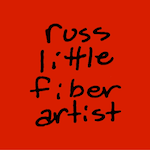Dye mixing experiment
In my Sept 10 posting I said that I was having some problems mixing print paste using ProChem MX 108 (Sun Yellow) but no other color. I called ProChem tech support and explained that every time I mix this particular dye with a thickener (ProChem Print Paste or Dharma Sodium Alginate) the thickener curdles like tapioca and is virtually unusable. I got the impression from their rather candid response that they were really stumped. The bottom line from ProChem was:
- The age of the dye powder (18 months) shouldn't cause this sort of behavior.
- They've never heard of anyone else with this problem.
- Mixing the dye powder with chemical water versus tap water shouldn't cause or prevent this problem.
- The thickener shouldn't be an issue either.
We discussed some possible experiments and agreed to stay in touch if either I or they came up with any conclusions. So, tonight I went to the basement to "play mad scientist," as Dan put it. Here's what I did.
I wanted to try several different thickened dye mixing procedures with controls for temperature of the thickener (which I store in the refrigerator), and the solution used to dissolve the dye. First I mixed a batch of Urea Water using the receipt on the ProChem website. Then I mixed two dye solutions:
- 3/4 tsp dye powder + 2 Tbls TAP WATER
- 3/4 tsp dye powder + 2 Tbls UREA WATER
I then measured out approximately equal amounts of sodium alginate thickener (about 10 days old):
- 2 bowls with cold alginate right out of the refrigerator
- 2 bowls with alginate that I had warmed to slightly above room temperature
I mixed the 4 possible combinations and discovered the following.
Dye really does dissolve better in urea water.
In the pictures below equal amounts of dye were dissolved in equal amounts of solution. On the left, the urea water produce a clear, well-dissolved mix. On the right, the tap water solution never fully dissolved and had bits of undissolved dye at the bottom of the cup.

Sodium alginate thickener is much easier to mix at room temperature.
The dye solution incorporated faster and the mixture returned to a smooth paste quickly in room temperature alginate. The cold alginate was gloppy (that's a technical term).
At the end of mixing the 4 batches I had failed to recreate the disastrous tapioca effect, so I just dumped everything together into one bowl and started mixing. I figured it was perfectly good dye; why waste it? And what happened!? It didn't curdle completely, but somewhat. My theory is that when I dumped the incompletely dissolved dye/tap water solution into the whole mix I also dumped in all of the undissolved bits at the bottom of the cup. In the controlled experiment I measured spoonfuls from the surface of the mixture and probably got few if any grainy bits.
So, while I don't have the time or patience to delve further into the science of what's happening here, my general conclusion regarding how to mix print paste with this particular color of dye powder (which should probably be applied to all colors) is:
- Bring the thickener to room temperature before mixing in the dye solution.
- Dissolve dye in urea water instead of tap water.
I almost wish I was back in high school so I could squeeze a science project out of this little exercise. Who knew that art could be so fussy?
